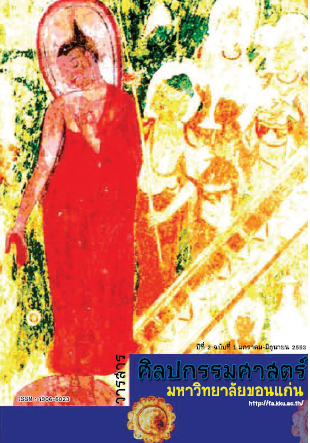การศึกษาเปรียบเทียบองค์ประกอบภาพจักรวาลในจิตรกรรมพุกามและจิตรกรรมไทยในสมัยรัตนโกสินทร์ตอนต้น
Main Article Content
Abstract
Although their origin is from different reigns of time, 'Buddhist Cosmology' mural paintings found in Late Pagan of Burmese art (around 18 - early 19 B.E.) and those from Early Ratanakosin (24 B.E.) may have something in common. Those are ùthe belief in Theravada Buddhismû and ùthe perception of the Buddhist Cosmologyû that both arts have shared together. It is believed that there is a link between of Late Paganûs pattern and Early Ratanakosin's.
Moreover, the illustrated book of Tri-Bumi (three worlds : earth, heaven and hell), which is presumable as the prototype of ùBuddhist Cosmologyû composition in Early Ratanakosin art, may be created around 22-23 B.E. From many previous comparative studies, it has been found that the perspective of ùBuddhist Cosmologyû paintings are always shown in 2 different ways: one is ùcrosscutû pattern, and another is ùverticalû pattern. The composition found in these 2 previous patterns is similar. That is to say, these pattern represents ùthe Universeû in Buddhism point of view as there are Meru Mountain (the central world-mountain) annularly surrounded by Satta Boriphan Mountains (7 mountain- walls, namely, Yugandhara, Isadhara, Karavîka, Sudassana, Nemindhara, Vinataka, and Assakan˛n˛a) and Sitantara oceans (7 annual seas) in alternation. Next to the outermost wall are unmeasured ocean, Tritung heaven, and 4 continents (namely, Uttarakuru ,Jambudvîpa, Pûrvavideha, and Aparagoyãna). All these components are rather arranged in the same composition as well as that has been used in çLord Buddha preached the Dhamma to his mother on the heavené scene.
However, in the same composition, there may have been some details in difference, such as, the form of architecture, space, and color. Particularly, in Pagan art, the Buddhist Cosmology is rather found as a part of çLord Buddha preached the Dhamma to his mother on Tritung heavené scene. In the painting, there are rather divided into 3 parts : one is that Load Buddha is proceeding to Tritung heaven, another is that Load Buddha is preaching Dhamma to his mother, and the last one is that Lord Buddha is proceeding back to the Earth. Also, there may be additional sub-story inserted in each part of the painting; for instances, while Lord Buddha is proceeding to Tritung heaven, Lord Buddha has turned to face King Phasentigoson who is sitting in Piyatad; and while proceeding back to the earth, Phra Mokkalana is prostrating to worship Lord Buddha. There is no sub-story shown in the scene like this in Thai mural painting. Diversely, in Ratanakosin Art, the Buddhist Cosmology in Lord Buddha preached the Dhamma to his mother on the heavené scene mostly consists of 3 events, which are that Lord Buddha is showing his miracle to torture the antagonists, that Lord Buddha is proceeding to Tritung heaven to preach the Dhamma to his mother, and that Lord Buddha is proceeding back to the earth, respectively. Besides, Thai Mural Painting presents the whole structure of Tri-Bumi, the three worlds in this preaching scene precisely, while Pagan Mural Painting presents only the ocean at the bottom part of the mural painting. In addition, çLoad Buddha proceeded back from Tritung heavené scene has just existed in the range of King Rama III, such as the mural painting at the ubosot of Wat Suwannaram. Also the mural painting in Early Ratanakosin period shows highly concentration on the ùJambudvîpa continentû by giving specific details in the mural painting such as a picture of Anodard underneath Satta Boriphan Mountains and Meru Mountain.Article Details
Content and information in articles published in the Journal of Fine and Applied Arts of Khon Kaen University is regarded as the opinion and sole responsibility of the author(s) directly; therefore, editors are not obliged to agree to or share any responsibility with regard to the content and information that appears within these articles.
All articles, information, content, image, etc. that have been published in the Journal of Fine and Applied Arts of Khon Kaen University is the copyright of the Journal of Fine and Appllied Arts of Khon Kaen University. Any person or organization who wishes to distribute all or parts of the articles for further dissemination or other usage must first receive permission from the Journal of Fine and Applied Arts of Khon Kaen University before proceeding to do so.


